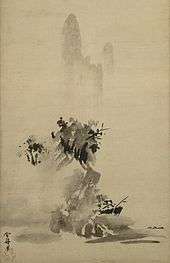Haboku

Splashed-ink Landscape (破墨山水 Haboku sansui) by Sesshū Tōyō, 1495
Haboku (破墨) and Hatsuboku (溌墨) are both a technique employed in suiboku (ink based), as seen in landscape paintings, involving an abstract simplification of forms and freedom of brushwork. The two terms are often confused with each other in ordinary use. Generally, haboku relies on a layered contrast black, gray and white, whereas hatsuboku utilizes "splashes" of ink, without leaving clear contours or outlines.[1] In Japan, these styles of painting were firmly founded and spread by the Japanese painter Sesshu Toyo.
References
- ↑ Ryūkyū Saitō. Japanese Ink-Painting: Lessons in Suiboku Techniques. p. 63. ISBN 0804832609.
This article is issued from Wikipedia - version of the 11/13/2016. The text is available under the Creative Commons Attribution/Share Alike but additional terms may apply for the media files.